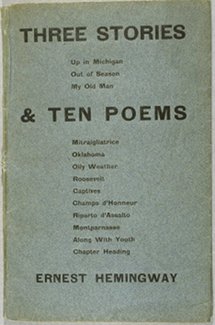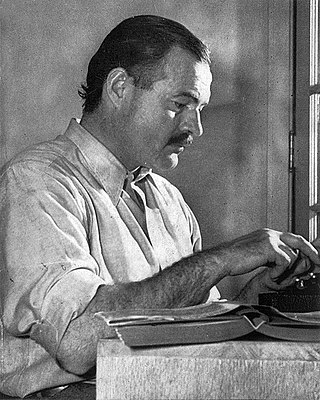
Ernest Miller Hemingway was an American novelist, short-story writer, and journalist. His economical and understated style—which he termed the iceberg theory—had a strong influence on 20th-century fiction, while his adventurous lifestyle and public image brought him admiration from later generations. Hemingway produced most of his work between the mid-1920s and the mid-1950s, and he was awarded the 1954 Nobel Prize in Literature. He published seven novels, six short-story collections, and two nonfiction works. Three of his novels, four short-story collections, and three nonfiction works were published posthumously. Many of his works are considered classics of American literature.
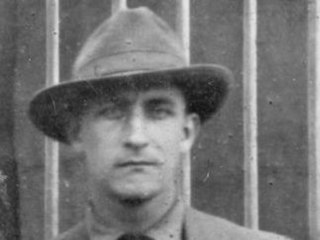
Robert Menzies McAlmon was an American writer, poet, and publisher. In the 1920s, he founded in Paris the publishing house, Contact Editions, where he published writers such as Ernest Hemingway, Gertrude Stein, James Joyce and Ezra Pound.
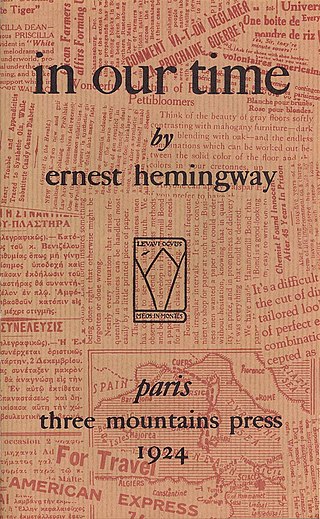
In Our Time is the title of Ernest Hemingway's first collection of short stories, published in 1925 by Boni & Liveright, New York, and of a collection of vignettes published in 1924 in France titled in our time. Its title is derived from the English Book of Common Prayer, "Give peace in our time, O Lord".

The Complete Short Stories of Ernest Hemingway: The Finca Vigía Edition, is a posthumous collection of Ernest Hemingway's short fiction, published in 1987. It contains the classic First Forty-Nine Stories plus a number of other works and a foreword by his sons.
Nicholas Adams is a fictional character, the protagonist of two dozen short stories and vignettes written in the 1920s and 1930s by American author Ernest Hemingway. Adams is partly inspired by Hemingway's own experiences, from his summers in Northern Michigan at his family cottage to his service in the Red Cross ambulance corps in World War I. The first of Hemingway's stories to feature Nick Adams was published in his 1925 collection In Our Time, with Adams appearing as a young child in the collection's first story, "Indian Camp".
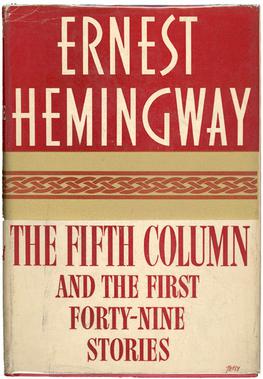
The Fifth Column and the First Forty-Nine Stories is an anthology of writings by Ernest Hemingway published by Scribner's on October 14, 1938. It contains Hemingway's only full-length play, The Fifth Column, and 49 short stories.

Men Without Women (1927) is the second collection of short stories written by American author Ernest Hemingway. The volume consists of 14 stories, 10 of which had been previously published in magazines. It was published in October 1927, with a first print-run of approximately 7600 copies at $2.

Complete Poems, originally edited and published in 1979 by Nicholas Gerogiannis and revised by him in 1992, is a compilation of all the poetry of Ernest Hemingway. Although Hemingway stopped publishing poetry as his fame grew, he continued to write it until his death in 1961.
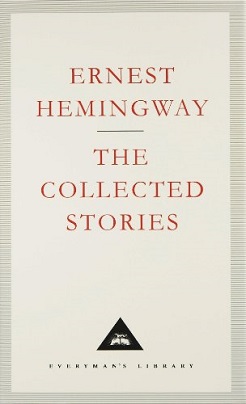
Ernest Hemingway: The Collected Stories is a posthumous collection of Hemingway's short fiction, published in 1995. Introduced by James Fenton, it is published in the UK only by Random House as part of the Everyman Library. The collection is split in two parts.

88 Poems is a book of the collected poetry of author Ernest Hemingway, published in 1979. It includes a number of poems published in magazines, the poems which appeared in Hemingway's first book, Three Stories and Ten Poems, and 47 previously unpublished poems that were found in private collections and in the Hemingway papers held by the Kennedy Library.
"Up in Michigan" is a short story by American writer Ernest Hemingway, written in 1921 and revised in 1938. It is collected in Three Stories and Ten Poems (1923) and The Fifth Column and the First Forty-Nine Stories (1938).

Ernest Hemingway (1899–1961) was an American novelist, short-story writer, journalist, and sportsman. His economical and understated style—which he termed the iceberg theory—had a strong influence on 20th-century fiction. Many of his works are considered classics of American literature.

"Indian Camp" is a short story written by Ernest Hemingway. The story was first published in 1924 in Ford Madox Ford's literary magazine Transatlantic Review in Paris and republished by Boni & Liveright in Hemingway's first American volume of short stories In Our Time in 1925. Hemingway's semi-autobiographical character Nick Adams—a child in this story—makes his first appearance in "Indian Camp", told from his point of view.

“The End of Something” is a short story written by Ernest Hemingway, published in the 1925 New York edition of In Our Time, by Boni & Liveright. The story is the third in the collection to feature Nick Adams, Hemingway's autobiographical alter ego.

"The Doctor and the Doctor's Wife" is a short story by Ernest Hemingway, published in the 1925 New York edition of In Our Time, by Boni & Liveright. The story is the second in the collection to feature Nick Adams, Hemingway’s autobiographical alter ego. "The Doctor and the Doctor's Wife" follows "Indian Camp" in the collection, includes elements of the same style and themes, yet is written in counterpoint to the first story.

"Cross Country Snow" is a short story written by Ernest Hemingway. The story was first published in 1924 in Ford Madox Ford's literary magazine Transatlantic Review in Paris and republished by Boni & Liveright in Hemingway's first American volume of short stories In Our Time in 1925. The story features Hemingway's recurrent autobiographical character Nick Adams and explores the regenerative powers of nature and the joy of skiing.

"My Old Man" is a short story written by Ernest Hemingway, published in his 1923 book Three Stories and Ten Poems, which published by a small Paris imprint. The story was also included in his next collection of stories, In Our Time, published in New York in 1925 by Boni & Liveright. The story tells of a boy named Joe whose father is a steeplechase jockey, and is narrated from Joe's point-of-view.

"Out of Season" is a short story written by Ernest Hemingway, first published in 1923 in Paris in the privately printed book, Three Stories and Ten Poems. It was included in his next collection of stories, In Our Time, published in New York in 1925 by Boni & Liveright. Set in Cortina d'Ampezzo, Italy, the story is about an expatriate American husband and wife who spend the day fishing, with a local guide. Critical attention focuses chiefly on its autobiographical elements and on Hemingway's claim that it was his first attempt at using the "theory of omission".

"On the Quai at Smyrna" is a short story written by Ernest Hemingway, first published in the 1930 Scribner's edition of the In Our Time collection of short stories, then titled "Introduction by the author". Accompanying it was an introduction by Edmund Wilson. Considered little more than a vignette, the piece was renamed "On the Quai at Smyrna" in the 1938 publication of The Fifth Column and the First Forty-Nine Stories. When In Our Time was reissued in 1955, it led with "On the Quai at Smyrna", replacing "Indian Camp" as the first story of the collection.
"Ten Indians" is a short story by American writer Ernest Hemingway, featuring protagonist Nick Adams, Hemingway's autobiographical alter ego. It was published in 1927 in the collection Men Without Women. The title is derived from a comment made by Mr. Garner - "That makes nine of them" - after moving an Indian who had passed out on the road. The title also alludes to the 1864 children's song, Ten Little Indians.
